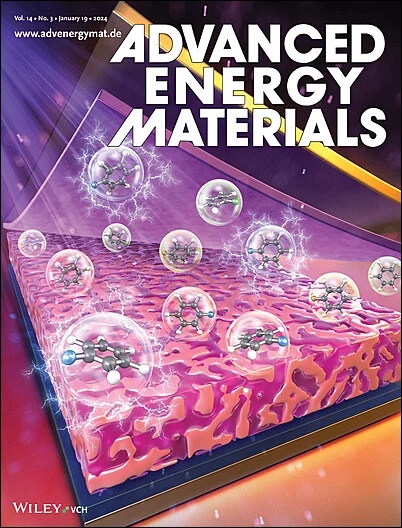用于高能量密度电池的大规模锂金属粉末电极界面稳定的定制粘合剂-导电中间层
IF 24.4
1区 材料科学
Q1 CHEMISTRY, PHYSICAL
引用次数: 0
摘要
为了解决通过传统挤压和压制工艺生产的锂金属电极在厚度和宽度上的限制,研究了一种利用锂金属粉末(LMP)的浆液基涂层方法,通过简单地调整涂层条件,可以制造超薄和宽宽的锂金属电极。尽管取得了这些进步,但LMP电极仍面临着严峻的挑战,包括由于界面处电解质的渗透和充放电循环过程中界面连通性的退化,LMP复合层从Cu集流器(CC)上脱落。为了缓解这些问题,在LMP复合层和Cu CC之间引入了由聚(3,4 -乙烯二氧噻吩)(PEDOT)和聚(苯乙烯磺酸盐- co -丙烯酸)(P(SS - co - AA)组成的粘接导电聚合物(AC -聚合物)中间层,以提高界面稳定性。交流聚合物中间层的加入显著降低了锂剥离过电位,从89.8 mV降至35.8 mV(降低了60%),并增强了循环稳定性,即使在碳酸盐基电解质中,在150次循环后,在4 mA cm - 2放电速率下也能保持91%的容量。300毫米宽和20微米厚的浆液涂层AC - LMP电极的成功制备代表了锂金属电池发展的显着进步。本文章由计算机程序翻译,如有差异,请以英文原文为准。
A Tailored Adhesive‐Conductive Interlayer for Interface Stabilization of Large‐Scale Lithium Metal Powder Electrodes for High‐Energy‐Density Batteries
To address the limitations in thickness and width of lithium (Li) metal electrodes produced through traditional extrusion and pressing processes, a slurry‐based coating method utilizing Li metal powder (LMP) is investigated, enabling the fabrication of ultra‐thin and broad‐width Li electrodes by simply tuning the coating conditions. Despite these advancements, LMP electrodes face critical challenges, including delamination of the LMP composite layer from the Cu current collector (CC) due to electrolyte infiltration at the interface and degradation of interfacial connectivity during charging/discharging cycles. To mitigate these issues, an adhesive‐conductive polymer (AC‐polymer) interlayer composed of poly(3,4‐ethylenedioxythiophene) (PEDOT) and poly(styrene sulfonate‐co‐ acrylic acid) (P(SS‐co ‐AA) is introduced between the LMP composite layer and the Cu CC to improve interfacial stability. The incorporation of the AC‐polymer interlayer significantly reduced the Li stripping overpotential from 89.8 to 35.8 mV (a 60% decrease) and enhanced cycling stability, achieving 91% capacity retention at a 4 mA cm−2 discharging rate after 150 cycles, even in a carbonate‐based electrolyte. The successful fabrication of a 300 mm‐wide and 20 µm‐thick slurry‐coated AC‐LMP electrode represents a notable advancement in the development of Li metal batteries.
求助全文
通过发布文献求助,成功后即可免费获取论文全文。
去求助
来源期刊

Advanced Energy Materials
CHEMISTRY, PHYSICAL-ENERGY & FUELS
CiteScore
41.90
自引率
4.00%
发文量
889
审稿时长
1.4 months
期刊介绍:
Established in 2011, Advanced Energy Materials is an international, interdisciplinary, English-language journal that focuses on materials used in energy harvesting, conversion, and storage. It is regarded as a top-quality journal alongside Advanced Materials, Advanced Functional Materials, and Small.
With a 2022 Impact Factor of 27.8, Advanced Energy Materials is considered a prime source for the best energy-related research. The journal covers a wide range of topics in energy-related research, including organic and inorganic photovoltaics, batteries and supercapacitors, fuel cells, hydrogen generation and storage, thermoelectrics, water splitting and photocatalysis, solar fuels and thermosolar power, magnetocalorics, and piezoelectronics.
The readership of Advanced Energy Materials includes materials scientists, chemists, physicists, and engineers in both academia and industry. The journal is indexed in various databases and collections, such as Advanced Technologies & Aerospace Database, FIZ Karlsruhe, INSPEC (IET), Science Citation Index Expanded, Technology Collection, and Web of Science, among others.
 求助内容:
求助内容: 应助结果提醒方式:
应助结果提醒方式:


